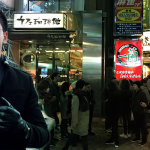One of the hot debate topics nowadays among fans of the Star Wars franchise is whether JJ Abrams’s The Force Awakens merely remade George Lucas’s first Star Wars film, A New Hope. But what a majority of viewers may not know is that A New Hope itself copied elements from the 1958 Japanese classic film, The Hidden Fortress.
The Hidden Fortress was directed by highly-acclaimed Japanese filmmaker Akira Kurosawa whom Lucas—as well as other Hollywood directors of his generation, such as Martin Scorsese, Steven Spielberg, and Francis Ford Coppola— admired and was influenced by. In fact, Lucas has, on numerous occasions, acknowledged that Star Wars was greatly inspired by The Hidden Fortress.
In a 2001 interview, Lucas said that “The one thing that really struck me about The Hidden Fortress was the fact that the story was told from the two lowest characters. I decided that would be a nice way to tell the Star Wars story, which was to take the two lowest characters, as Kurosawa did, and tell the story from their point of view, which in the Star Wars case is the two droids.”
But just how similar is Star Wars to The Hidden Fortress? Here are five similar elements between the two films.
1) The Droids. C3PO is a tall protocol droid and R2D2 is a short astromech droid. Both service droids are dragged into a war between the empire and the rebellion. In The Hidden Fortress, a tall peasant (Tahei, played by Minoru Chiaki) and a short peasant (Mataschichi, played by Kamatari Fujiwara) are caught up in Japan’s 16th Century Civil War. Both pairs squabble, get separated, get captured, are reunited, and then get caught up again in the midst of the conflict.
2) The Princess. In The Hidden Fortress, Tahei and Mataschichi have to help a grizzled general escort Princess Uki (played by Misa Uehara) home. In Star Wars, after enlisting the help of an old and bearded Obi-Wan Kenobi, the droids have to help in freeing the captured Princess Leia and in returning her to the rebel base.
3) The General. Lucas admired Toshiro Mifune’s work in The Hidden Fortress and, according to a BBC article, even considered him for the part of Obi-Wan Kenobi, a role that eventually was taken on (with great regret) by Sir Alec Guinness. Both Mifune’s and Guinness’s characters were bearded generals, veterans of the raging wars.
4) Other similar characters. Both films feature a very corrupt and corpulent slave trader/underworld boss. It’s just that in The Hidden Fortress, the slave owner is human while in Star Wars, it’s Jabba the Hutt. Both movies also feature a scarred and flawed villain who suddenly has a change of heart in the end.
5) Settings and cinematic techniques. In The Hidden Fortress, the story begins in a desert. While in A New Hope, the story is largely set on the desert planet of Tattooine. In The Hidden Fortress, certain events happen in a large forest, just as the Star Wars story shifts to the forest moon of Endor in The Return of the Jedi. Over on the technical side, both Kurosawa and Lucas make use of the horizontal and vertical swipes to transition between scenes.
Despite the similarities, Lucas has maintained that these are “more of a coincidence than anything else.” But it is still fascinating to see how much of Kurosawa’s influence has made it onto the Star Wars films. If you want to see a side-by-side comparison, here is a video prepared by the folks at Star Wars Minute as uploaded on YouTube:


